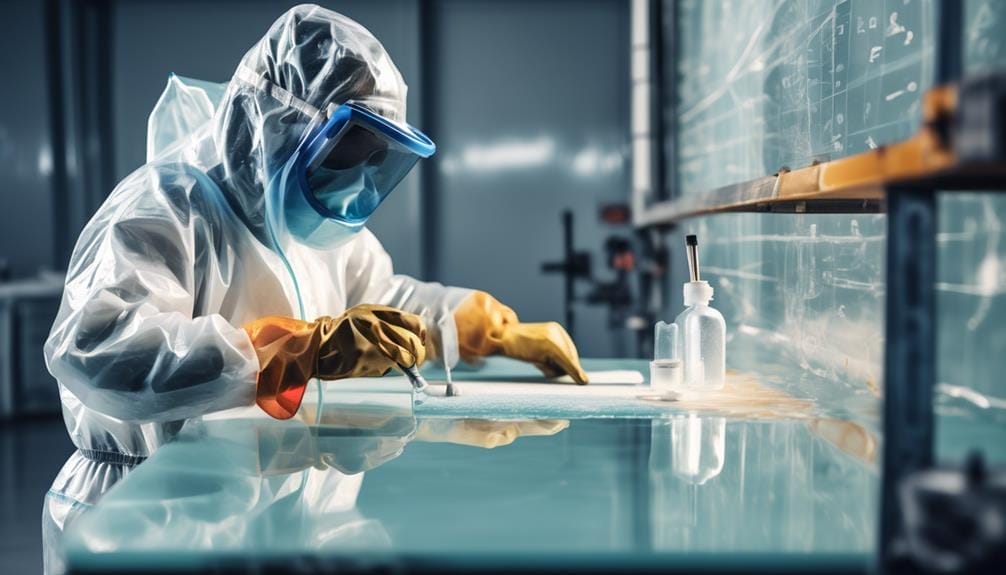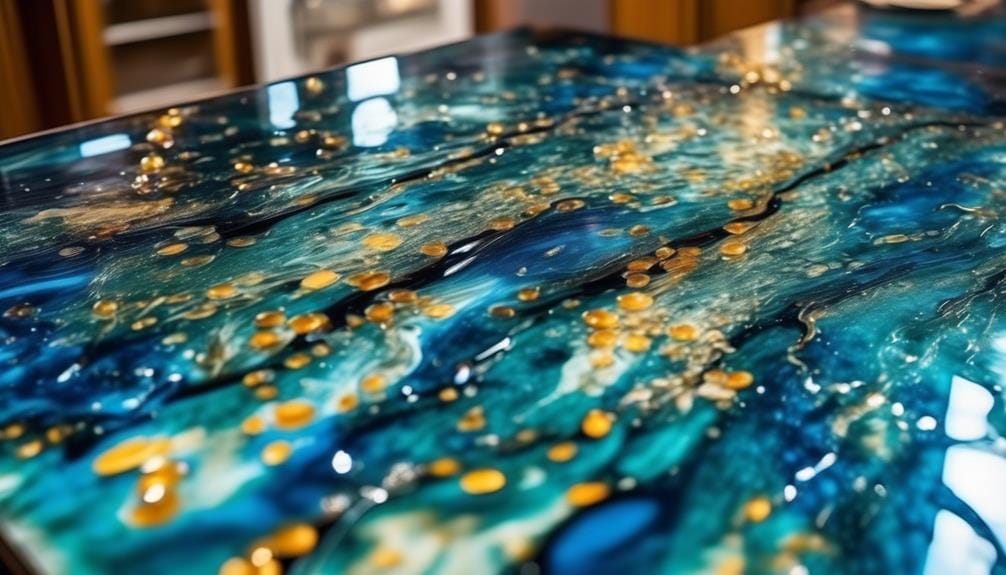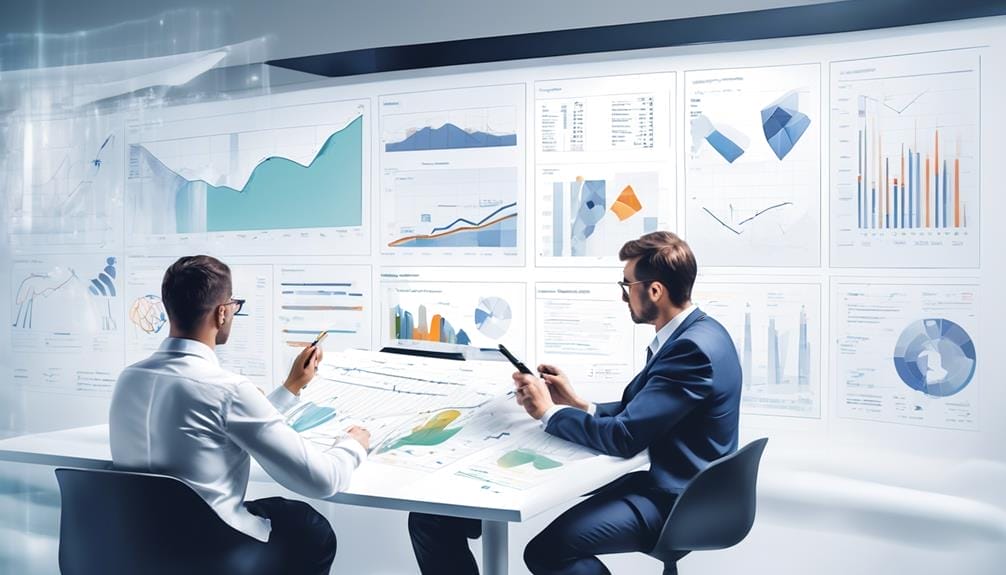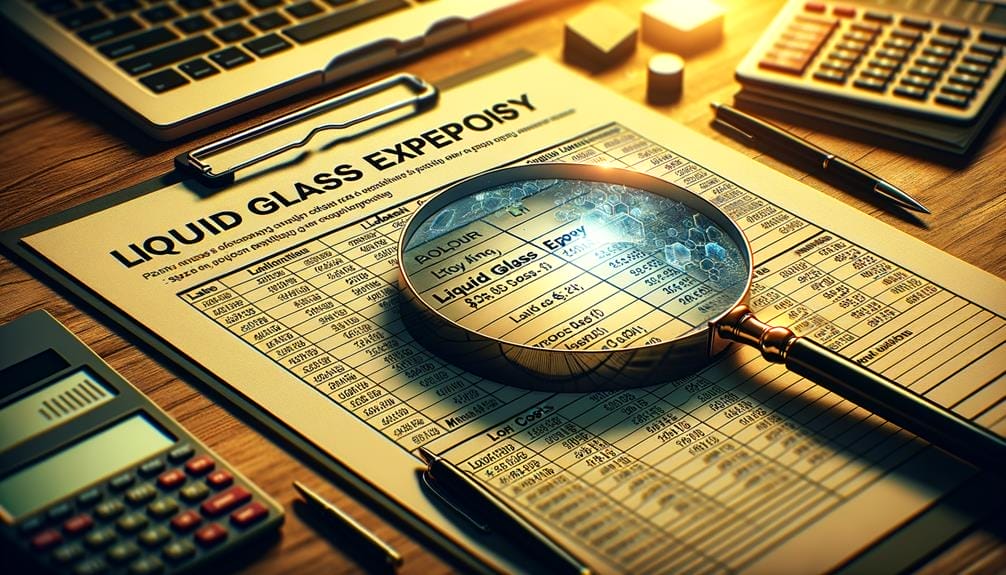So, you're thinking about undertaking a liquid glass epoxy project, huh? Well, buckle up, because the cost analysis of these projects is about to blow your mind.
We're talking about a cost-effective option that can rival materials like tile or marble. But that's not all. There's so much more to uncover, from the easy installation and maintenance to the health benefits and long-lasting durability.
Trust me, you won't want to miss out on this. Stay tuned to find out how liquid glass epoxy can revolutionize your project, and maybe even your life.
Key Takeaways
- Superclear Table Top Epoxy is a cost-effective option compared to alternative materials like granite, marble, wood, and stainless steel.
- The material cost breakdown includes epoxy, pigments, and accessories such as mixing containers, stir sticks, gloves, and brushes.
- Cost-saving strategies include looking for sales and coupon codes, opting for a DIY approach, and considering optional extras like pigments and accessories.
- When estimating labor costs, factors such as project size, complexity of design, DIY vs. professional installation, and additional requirements should be taken into account.
Understanding the Project Scope
Understanding the project scope involves thoroughly evaluating the cost comparisons between Superclear Table Top Epoxy and other materials. It's essential to take into account factors such as sales, coupon codes, labor costs, optional extras, and long-term benefits.
When considering the cost of Superclear Table Top Epoxy, it's crucial to compare it with alternative materials like granite, marble, wood, and stainless steel. Each material has its own cost and benefits, so it's important to analyze which option is the most cost-effective for your project.
When it comes to the cost of labor, professional installation costs for epoxy projects can vary significantly. Understanding the project scope requires evaluating the labor and material costs associated with using Superclear Table Top Epoxy.
Additionally, opting for a DIY approach can offer cost savings, but it's important to consider any optional extras like pigments and accessories that may add to the overall project cost.
Long-term benefits should also be considered when evaluating the project scope. Superclear Table Top Epoxy provides a durable and resistant finish, making it resistant to stains, scratches, and water damage. This durability can contribute to cost savings over time, as the need for repairs or replacements is reduced.
Calculating Material Costs
When calculating material costs for your epoxy project, it's important to break down the components that contribute to the overall cost. This includes considering the price of epoxy per gallon, as well as any additional accessories like pigments and dyes.
To determine the most cost-effective option, compare the cost of professional installation to the DIY approach with Superclear Table Top Epoxy.
Additionally, evaluating the long-term benefits of using epoxy, such as its durability and resistance to damage, can help in analyzing costs by factoring in potential maintenance and replacement savings.
Material Cost Breakdown
To accurately budget for your liquid glass epoxy project, it's crucial to calculate the material costs by evaluating the expenses for epoxy, pigments, accessories, and any additional items needed for the project.
Here is a breakdown of the material costs:
- Epoxy: The main component of your project, the Superclear Epoxy or Glass® Deep Pour Epoxy, will be the largest expense. Consider the quantity needed based on the size of your project.
- Pigments: If you want to add color to your epoxy, pigments are essential. Determine the required amount and choose from a variety of pigments available on the market.
- Accessories: To ensure a successful application, you may need accessories such as mixing containers, stir sticks, gloves, and brushes. These items are necessary for the proper use of the epoxy.
- Additional Items: Depending on your specific project, you may need additional items like the Superclear Epoxy Cleaner to clean the surface before application or a Durable Bar Top Epoxy for added protection.
Cost-Saving Strategies
To effectively manage your material costs for your liquid glass epoxy project, it's important to implement cost-saving strategies when calculating the expenses.
One cost-saving strategy is to choose Superclear Table Top Epoxy, which is priced at around $60 per gallon, making it a cost-friendly option compared to other epoxies that can be over $100 per gallon. Additionally, sales and coupon codes are frequently available for Superclear Table Top Epoxy, further enhancing its affordability.
Opting for a DIY approach with Superclear Table Top Epoxy can also lead to significant cost savings, with materials costing just $5 to $10 per square foot. Furthermore, extras like pigments and accessories are optional and may require additional cash, allowing for flexibility in managing material costs.
Estimating Labor Costs

When estimating labor costs for your liquid glass epoxy project, there are several factors to consider. These factors include project size, complexity, and the experience level of the labor force.
Additionally, it's important to calculate the hourly rates based on the time required for surface preparation, mixing and application of the epoxy, as well as any additional labor for custom designs or intricate details.
Taking into account these factors will help you accurately estimate labor costs and ensure a competitive rate for your project.
Labor Cost Factors
What factors should be considered when estimating labor costs for liquid glass epoxy projects?
When estimating labor costs for liquid glass epoxy projects, it's important to take into account several key factors. These factors can greatly impact the overall expenses and help ensure an accurate estimation.
Here are the labor cost factors to consider:
- Project size: The size of the project plays a significant role in determining labor costs. Larger projects typically require more time and effort, resulting in higher labor expenses.
- Complexity of design: Customized designs or intricate patterns may require additional labor and expertise, leading to increased costs.
- DIY vs. professional installation: Opting for DIY installation can save on labor expenses, but it also requires time, skill, and experience. Professional installation, on the other hand, ensures quality workmanship but comes with higher labor costs.
- Additional requirements: Certain projects, such as a live edge epoxy bar or river wood table, may involve specific techniques or materials that require specialized labor, leading to higher costs.
Calculating Hourly Rates
Calculating hourly rates is a crucial step in accurately estimating labor costs for liquid glass epoxy projects, as it allows for a precise evaluation of the financial implications and aids in making informed budget decisions. By factoring in the hourly wages of the workers, including any additional benefits or overhead costs, you can determine the true cost of labor for your project. Understanding the time required for various tasks enables a more accurate estimation of labor expenses. This information is essential for ensuring that the labor costs are aligned with the project's financial objectives. To assist in visualizing this process, refer to the table below:
| Labor Cost Factors | Hourly Rate (in USD) |
|---|---|
| Worker wages | $20 |
| Employee benefits | $5 |
| Overhead costs | $10 |
| Total hourly rate | $35 |
Assessing Equipment and Tool Expenses
To effectively budget for liquid glass epoxy projects, it's imperative to thoroughly assess the expenses associated with acquiring the necessary equipment and tools. Proper tools are essential for achieving professional-quality results while working with liquid glass epoxy.
Here are four key considerations when assessing equipment and tool expenses for your project:
- Mixing Containers: Investing in high-quality mixing containers is crucial for ensuring accurate and efficient epoxy mixing. Look for containers that are durable, easy to clean, and have clear measurements for precise mixing ratios.
- Stirring Sticks: Choose stirring sticks made of sturdy materials like wood or plastic, as they provide optimal mixing results. Avoid using metal stirring sticks, as they can potentially damage the epoxy.
- Leveling Tools: Achieving a level surface is important for a smooth and even epoxy application. Consider investing in leveling tools such as self-leveling lasers or bubble levels to ensure accurate leveling throughout the project.
- Research and Compare Prices: To find cost-effective options, research and compare prices for equipment and tools from different suppliers. Take into account factors such as quality, durability, and customer reviews when making your purchasing decisions.
Factoring in Additional Project Expenses

When considering the cost of a liquid glass epoxy project, it's crucial to factor in additional expenses beyond just the materials and equipment.
A comprehensive cost breakdown should include hidden expenses such as labor, optional accessories, and professional installation if needed.
DIY projects may save on installation costs, but it's important to account for additional expenses like tools, equipment, and protective gear.
Cost Breakdown
Factoring in additional project expenses, the cost breakdown for liquid glass epoxy includes pigments, accessories, and cleaning materials. These additional expenses are necessary to achieve the desired look and maintain the longevity of the epoxy.
Here is a breakdown of the costs involved:
- Pigments: Investing in an epoxy that allows for customization with pigments is essential for achieving the desired color and aesthetic. These pigments can range in price depending on the brand and quality.
- Accessories: Various accessories such as mixing tools, application brushes, and protective gear are necessary for a successful epoxy installation. These items may seem small, but they contribute to the overall cost of the project.
- Cleaning materials: One of the best cleaning options for liquid glass epoxy is the Superclean Epoxy Cleaner. This cleaner effectively removes dirt, grime, and stains without damaging the epoxy surface. Investing in a high-quality cleaner is crucial for maintaining the longevity and appearance of the epoxy.
- Miscellaneous expenses: It's important to consider any other miscellaneous expenses that may arise during the project, such as tape, drop cloths, or additional tools. These small items can add up and should be factored into the overall cost breakdown.
Hidden Expenses
Hidden expenses can significantly impact the overall cost of liquid glass epoxy projects when factoring in additional project expenses. While the material costs of liquid glass epoxy may seem reasonable, there are other factors to consider. One of the hidden expenses is pigments and accessories, which can add to the total cost. Additionally, if you opt for professional installation, labor costs can range from $45 to $140 per square foot. However, if you choose to do it yourself, it is important to ensure proper mixing to avoid any issues. This is because as the epoxy cures, bubbles can rise to the surface if the surface is not completely level. These bubbles can compromise the structural integrity of the project and may require additional repairs. It is also worth noting that liquid glass epoxy offers easy cleanup, saving you time and money. To give you a clearer understanding, here is a table showcasing the potential hidden expenses:
| Hidden Expenses | Cost Range ($) |
|---|---|
| Pigments | $5 – $30 |
| Accessories | $10 – $50 |
| Professional Installation | $45 – $140 per sq ft |
Analyzing Cost-Effectiveness Compared to Other Materials
Liquid glass epoxy and other epoxy surfaces are known for their cost-effectiveness compared to materials like tile or marble, making them a popular choice for various applications.
Here are four reasons why they're considered a more economical option:
- Long-lasting durability: Epoxy surfaces have excellent resistance to wear and tear, ensuring a good return on investment. Unlike tile or marble, which may crack or chip over time, epoxy surfaces can withstand heavy traffic and remain intact for years.
- Energy-saving properties: Liquid glass coating, such as Liquid Glass® Deep Pour, can help reduce energy costs. The coating creates a barrier that prevents heat transfer, keeping the surface cool. This can lead to lower cooling expenses, especially for outdoor areas like riverfront patios or pool decks.
- Cost-effective material: Epoxy materials can be purchased in large quantities for a relatively low cost. This makes them an affordable choice for projects that require a significant amount of surface coverage.
- Easy installation: Epoxy surfaces can be applied directly over existing surfaces, eliminating the need for time-consuming demolition and preparation. This not only saves on labor costs but also minimizes downtime, allowing you to make the most of your space quickly.
Considering these factors, it's evident that liquid glass epoxy and other epoxy surfaces offer a cost-effective solution compared to traditional materials like tile or marble. Whether you're looking for durability, energy efficiency, or ease of installation, epoxy surfaces prove to be the best choice for a wide range of applications.
Considering Long-Term Maintenance Savings

When considering long-term maintenance savings, epoxy surfaces like Superclear Epoxy offer a cost-effective solution due to their resistance to stains, scratches, and water damage. This durability ensures that your investment in an LED Epoxy Bar Top or any other epoxy project will last for years to come, saving you money on repairs and replacements.
Superclear Epoxy is known for its crystal clear, glass-like finish that adds a touch of elegance to any surface. It's easy to pour into a clean surface and cures to a hard, durable coating that can withstand the wear and tear of daily use.
Unlike materials like granite, marble, wood, and stainless steel, epoxy surfaces require minimal maintenance and retain their beauty for an extended period. Real-world testimonials from satisfied customers further highlight the long-term benefits and cost-effectiveness of Superclear Epoxy.
Examining Real-World Cost Scenarios
To further understand the cost implications of using Superclear Epoxy, it's important to examine real-world cost scenarios that demonstrate its affordability and potential savings. Here are four contextually relevant examples:
- DIY Countertop Project: By opting for a DIY approach, you can save significantly on labor costs. For instance, if you choose Superclear Epoxy for a standard-sized countertop of 30 square feet, the material cost would be around $300. In comparison, professional installation costs for the same area could range from $1,350 to $4,200.
- Flooring Renovation: Let's say you have a 500 square foot space that requires a new epoxy floor coating. If you hire professionals, labor costs alone might amount to $22,500. On the other hand, purchasing Superclear Epoxy for this project would cost approximately $2,500, resulting in potential savings of $20,000.
- Artistic Creations: For artists and crafters, Superclear Epoxy provides an affordable option for creating stunning resin artwork. A typical small piece, measuring around 12 inches by 12 inches, would require less than a gallon of epoxy, costing approximately $60. This allows artists to experiment and create without breaking the bank.
- Commercial Applications: In larger-scale commercial projects, such as restaurant bar tops or hotel lobby tables, the cost savings can be substantial. For a 100 square foot bar top, using Superclear Epoxy could result in material savings alone of $4,000 compared to more expensive epoxy alternatives.
Exploring Affordable Liquid Glass Epoxy Options

Exploring the cost-effective options available for liquid glass epoxy can provide homeowners and DIY enthusiasts with affordable and high-quality solutions for various projects. One top option for a cost-friendly liquid glass epoxy is Superclear Table Top Epoxy, priced around $60 per gallon. Compared to other epoxies that can exceed $100 per gallon, this option offers significant savings. Additionally, opting for a DIY approach with Superclear Table Top Epoxy can save money on professional installation costs. While professional labor for epoxy bar tops can cost between $45 to $140 per square foot, using this affordable epoxy allows you to tackle the project yourself.
To further illustrate the affordability of liquid glass epoxy options, consider the following table:
| Liquid Glass Epoxy Options | Features |
|---|---|
| Superclear Table Top Epoxy | – Cost-friendly at around $60 per gallon<br>- DIY-friendly with bubble-free, smooth finish<br>- Resists stains, scratches, and water damage |
| Liquid Glass Deep Pour Epoxy | – Deep pour capability of 2-4 inches<br>- Eliminates 75% of work<br>- Provides unmatched industry performance and convenience |
Evaluating the Durability of Liquid Glass Epoxy
Evaluating the durability of liquid glass epoxy involves a thorough assessment of its resistance to stains, scratches, water damage, and its ability to maintain its gloss and beauty over years of use.
Here are four key aspects to consider when evaluating the durability of liquid glass epoxy:
- Stain Resistance: Liquid glass epoxy is known for its excellent resistance to stains. It forms a protective barrier that prevents liquids from penetrating the surface, making it easier to clean and maintain.
- Scratch Resistance: The durability of liquid glass epoxy is further enhanced by its ability to withstand scratches. Its high hardness and resilience make it less susceptible to damage caused by everyday use and wear and tear.
- Water Damage Resistance: Liquid glass epoxy is highly resistant to water damage. Its impermeable surface ensures that water can't seep into the material, protecting it from warping, swelling, or other forms of water-related damage.
- Air Bubble Prevention: One key factor in evaluating the durability of liquid glass epoxy is its ability to create a smooth and bubble-free finish. The low viscosity formulation allows air bubbles to rise to the surface as it cures, ensuring a flawless result. This not only enhances the appearance but also contributes to its long-term durability.
Making Informed Decisions for Efficient Project Management

When considering efficient project management, it's crucial to make informed decisions based on factors such as cost analysis, long-term benefits, and real-world testimonials.
Conducting a cost analysis is an integral part of project planning, as it helps determine the most cost-effective options for liquid glass epoxy projects. For instance, Superclear Table Top Epoxy is priced at around $60 per gallon, making it an attractive choice compared to other more expensive epoxies. Additionally, opting for a DIY approach can result in significant cost savings for installation labor, which can range between $45 to $140 per square foot for professional installation of epoxy bar tops.
In addition to cost considerations, it's essential to evaluate the long-term benefits of using liquid glass epoxy for projects. Superclear Epoxy, for example, offers resistance to stains and scratches, reducing maintenance and replacement costs over time. This durability makes it a wise investment for various applications, ensuring that your project remains intact and visually appealing for years to come.
Real-world testimonials can also provide valuable insights when making informed decisions about liquid glass epoxy projects. Customers who've used Superclear Epoxy have highlighted its quality, reliability, and versatility. These testimonials can help you gain confidence in the product's performance and make informed choices about its suitability for your specific project requirements.
Frequently Asked Questions
How Much Does Epoxy Pour Cost?
Epoxy pour costs vary based on factors like project size, materials, and labor. DIY can save money with sales and coupons. Consider the breakdown of materials vs. labor expenses. Tips for reducing costs include efficient epoxy pour techniques.
What Is the Ratio for Liquid Glass Epoxy?
The ratio for liquid glass epoxy is typically 1:1, meaning equal parts of resin and hardener are mixed together. Following this mixing instruction is crucial for achieving the desired properties and finish of the epoxy.
Why Is Epoxy so Expensive?
Epoxy is expensive due to the advanced manufacturing process and high-quality materials used. Comparing it to other materials, epoxy offers long-term durability and performance. Factors like market trends and environmental impacts also contribute to its pricing.
How Long Does It Take for Liquid Glass Epoxy to Cure?
The curing process of liquid glass epoxy depends on various factors such as temperature, thickness of the pour, and type of project. To speed up curing, ensure proper temperature and avoid common mistakes like inadequate mixing. Different epoxy brands may have varying cure times.
Conclusion
In conclusion, the cost analysis of liquid glass epoxy projects reveals that they offer a cost-effective option for various projects.
One interesting statistic to note is that epoxy surfaces and liquid glass can be purchased at a relatively low cost, compared to materials like tile or marble.
This allows for more affordable project options without compromising on quality or durability.
Overall, choosing epoxy surfaces and liquid glass is a practical and efficient solution for long-lasting and versatile projects.





